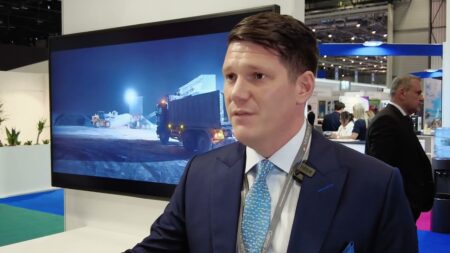Words by Abigail Williams
The few electric aircraft in use today are small and light general aviation and trainer aircraft. As the drive to make aviation more sustainable continues, experts predict that as battery capacity increases, general aviation and business aircraft, then regional aircraft will electrify first. This means that smaller airports and FBOs will need to provide electrical charging infrastructure ahead of larger commercial airports.
USA projects
As the battery capacity of electric aircraft continues to improve, a growing number of manufacturers and airports are turning their attention to the installation of appropriate charging infrastructure. One prominent example is electric aircraft manufacturer Pipistrel, which was recently acquired by US conglomerate Textron. Pipistrel sells its in-house built SkyCharge charging systems in partnership with power management company Eaton.
Pipistrel has already worked on a range of projects, including the 2019 installation of the first commercial electric aircraft charging station in the US at Compton / Woodley Airport in Los Angeles County.
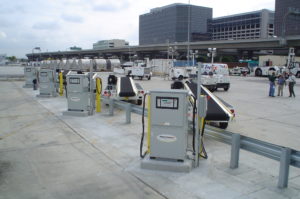
Electric aircraft developer Eviation has also recently partnered with California based business aviation company Clay Lacy Aviation to provide electric charging for its Alice aircraft at Clay Lacy FBOs ahead of Alice’s expected entry into service in 2024.
According to Scott Cutshall, senior vice president – development and sustainability at Clay Lacy, the company is excited about the Eviation partnership, and is currently focused on “developing the most cost effective and expedient way to deliver charging to the aircraft”.
“We are designing and sizing solar arrays at our facilities to generate clean, sustainable electricity, coupled with on-site battery storage for that power. Our guiding philosophy is that we must generate a large portion of the electricity in a sustainable way to realize the full gamut of environmental benefits electric aviation offers,” he says.
Nordic electric
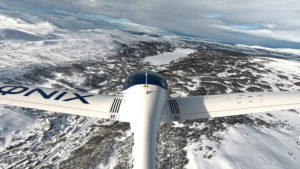
For the last two years Swedavia has been working to prepare its ten airports across Sweden to handle electric aircraft, in anticipation of commercial electrified routes becoming operational by 2025. It has been testing infrastructure and aircraft at a site called Green Flyway at Åre Östersund Airport since 2020. The government-owned airport operator has already installed parking stands, charging infrastructure and the power supply needed to ensure the necessary permits at the site. The first test flights occurred between Åre Östersund Airport and Røros Airport in Norway in October 2020.
“We are nearing 18 months since the centre started and are focusing our efforts on ensuring that the airport’s infrastructure is ready to handle commercial electric aircraft in the future,” says Peter Fahlén, airport director at Åre Östersund Airport.
Fahlén adds that Umeå Airport and Visby Airport are also in the initial stages of developing electric aviation infrastructure. Umeå Airport is also taking part in a project looking at running electrified flights between Sweden and Finland. In addition there is a case study ongoing of an electric air route between Umeå and Åre Östersund.
“We are confident of the increasing potential for commercial electric aviation in Sweden in the coming years. For primarily domestic flights they will be a welcome addition to regular routes, linking regional centres and creating opportunities within air transport,” adds Fahlén.
Charging solutions
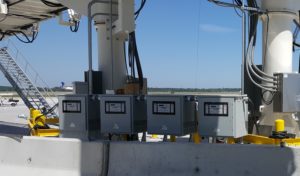
Elsewhere, aviation consultant ICF is working on several projects involving electrical infrastructure and aviation. These range from forecasting demand and planning, to delivering infrastructure both groundside and airside in airports.
“Last year, we supported installation of charging points at small general aviation airports for a major electrical aircraft OEM. Our network of partners covers the entire ecosystem, including OEMs, technology providers, airports, FBOs, logistic providers, government agencies, laboratories, and academia,” says Eliot Lees, vice president of clean transportation at ICF.
UK Power Networks Services (UKPNS) provides energy infrastructure solutions to airports including Heathrow and Gatwick. It is working as part of a consortium of companies led by electric aircraft developer Ampaire to investigate the technical feasibility of three different potential charging solutions to charge hybrid-electric aircraft.
These solutions include rapid plug-in chargers at the apron and slow chargers installed in hangers or at parking locations for charging overnight or during downtime. Another option is a vehicle with an on-board battery able to charge aircraft at the apron overnight and at a charging location. Finally a battery swap operation performed at the apron is also being considered.
Rahul Desai, senior consultant at UKPNS says, “We also helped assess the opportunities for a future scale-up and wider use of electric aircraft including the electrical infrastructure requirements and the approach to building the local energy system.
“The consortium has already delivered a successful demonstration of Ampaire’s hybrid-electric Electric EEL aircraft, which was flown around 85 miles [137km] between Exeter Airport and Cornwall Newquay Airport.”
Existing requirements
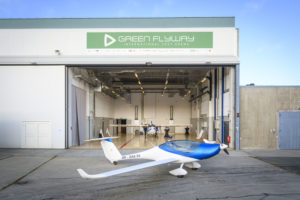
Equipment on-board aircraft is powered during flight using electricity generated from the engines. While on the ground auxiliary power units (APU) or mobile or fixed ground power units (GPU) can also provide power to aircraft equipment. These GPUs provide direct current (DC) or alternating current (AC) to power the needs of each aircraft.
DC ground power is typically used for general aircraft, smaller jets and turboprop airplanes, while AC power is used for larger commercial and business aircraft. GPUs provide electricity to the aircraft either using generators or by connecting direct to the grid.
Chris Watson, beneficial electrification portfolio director at ICF says, “This need will not change. Electric aircraft will still need their equipment powered during flight and while on the ground, and it will largely be done in the same manner – via GPUs that connect to the aircraft.
“Electric aircraft recharging infrastructure for batteries is in most cases not in place today. In many cases this infrastructure may be difficult or costly to put in place.”
Desai notes that most major international airports now provide a choice between either Fixed Electrical Ground Power (FEGP) and mobile battery-powered GPUs. This avoids the use of fossil fuel APUs to reduce emissions and noise pollution.
Standard FEGPs are 90kVA or 180kVA units that are sufficient to supply an aircraft’s electrical devices and systems whilst at the stands. For larger aircraft, more than one FEGP could be required to supply the plane’s auxiliary circuits. For example, an Airbus A380 requires 2x 180kVA or 4 x 90kVA to power all of its onboard services.
“We expect a number of smaller, electric-powered aircraft to enter the market in the next five years. These are unlikely to be parked at the same standard stands used by larger, traditional aircraft,” says Desai.
“To enable the integration of smaller electric aircraft, airports may need to install chargers at stands where such smaller aircraft park.
“Airports could investigate using the existing FEGP infrastructure and configure these for the charging of
on-board aircraft batteries.
“With a broader adoption of electric or hybrid planes, the energy requirements of airports will increase. This will require additional ground infrastructure to meet the increase of demand and ensure its resilience,” he adds.
Future needs

Lees points out that a number of industry groups are currently pushing to standardize the electric aviation market “well ahead of the timeframe it’s taken the electric vehicle market to begin alignment” and that “technological improvements are allowing greater charging speeds to be developed for both the vehicle and aircraft markets”.
An example is the Charin Task Force – which has successfully developed the Megawatt Charging System (MCS) and aligns the vehicle and aircraft markets.
“One of the most significant issues facing the aviation industry, especially at smaller airports and FBOs, is that the fuel needed to power electric aviation comes via conduit and wires, not the fossil fuel pipes that are already in the ground,” says Lees.
“Small airports do not generally have significant energy capacity at the locations where it will be needed to charge aircraft or ground equipment. This means additional infrastructure needs to be delivered, sometimes significant distances away from where it exists. This is a significant cost implication for electric aviation.”
Desai points out that many smaller airports are already looking into strengthening airside electrical infrastructure by providing supplies to electric ground support vehicles, transport buses and passenger car parks. Extra electrical infrastructure needed may include new substations and network upgrades to increase the capacity of existing electrical connections. On-site renewable energy sources can also be integrated in private networks to help reduce energy costs and the carbon footprint.
“Airports should use their budgets to ensure their energy strategy delivers OPEX cost savings and carbon reductions whilst proving future capacity to meet changing energy demands,” says Desai. “The timing of investment is critical to ensure capacity is available ahead of need, but not too early so you pay for availability which is not yet required,” he says.
“To optimize investment and existing import capacity to accommodate electric aircraft, airport operators may look at the possibility of smart charging, similar to what we are seeing in the electric vehicle market. Not all of the aircraft will need charging at the same time.”
Commercial challenges
According to Watson smaller airports and FBOs financing the installation of charging networks requires a significant up front investment many locations will not have. He believes that commercial, business and general aviation and cargo will have different charging needs that will need to be met.
Commercial electric aircraft operators operating to a schedule will need certainty of charging availability and dedicated charging stations. However, as electric aircraft operation ramps up, the cost won’t make economic sense to airlines.
“Commercial operators will be reluctant to make this investment. So, in the short term, either OEMs or the airports need to make this investment or the charging infrastructure may not be built,” says Watson.
Meanwhile, business and general aviation does not typically operate on a schedule, making sharing charging capacity more likely. This makes up front investment in charging infrastructure more attractive to FBO chains. However, there will be peak requirements for charging that will translate into the need for extra capacity that will only be used on a standby basis.
“Cargo operations are the most likely to launch first with predictable routes and predictable charging requirements. The initial investment could be made by cargo operators and shared with others at times during the day when it is not needed,” says Watson.
“But the up front investment and the length of payback are a key challenge in the launch of electric aviation that the industry has not fully come to grips with.
“At many airports, this will be a difficult dilemma that must be solved to bring needed power for electric aircraft,” he adds.
Desai believes that small airports should “start developing a good understanding of the future energy requirements and the electrical infrastructure that would need to be upgraded”.
“Domestic and regional aircraft routes could be the first ones to go electric. Larger airports may see a growth in smaller electric planes for private aircraft on short haul flights,” he says.
“All infrastructure investments have to be linked to the revenue that is to be earned from the investment, which in turn is linked to passenger fares. Good use of the aircraft charging network is important and aiming for use by multiple customers will put airports in the best place to complete infrastructure investments.”



